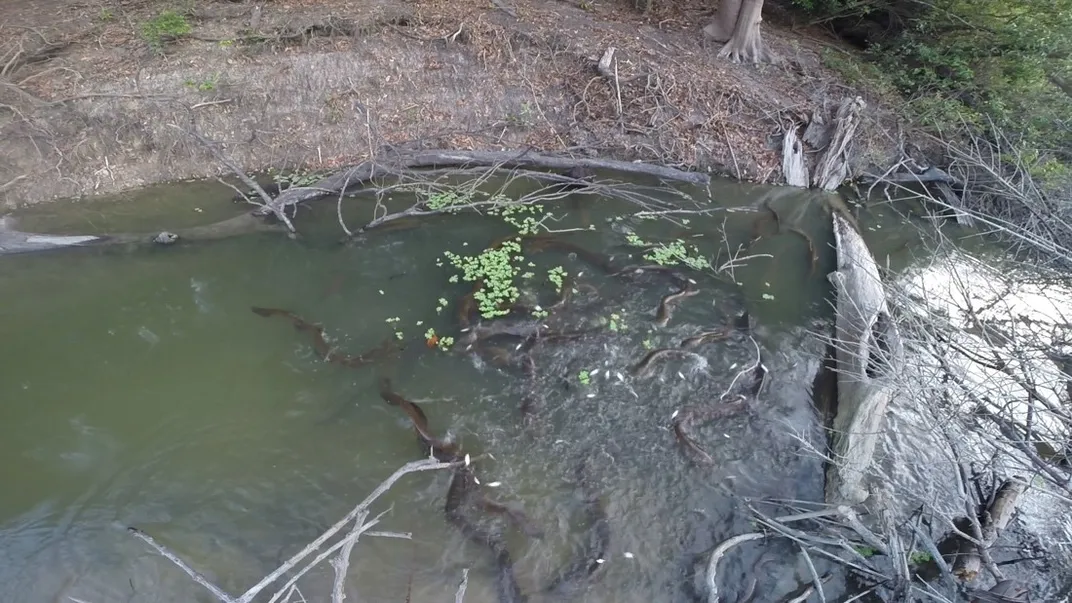NATIONAL MUSEUM OF NATURAL HISTORY
Shocking Study Finds Electric Eels Hunt Together
The study challenges what researchers know about eels’ supposed loner behavior.
/https://tf-cmsv2-smithsonianmag-media.s3.amazonaws.com/blogging/featured/A_eel_under_cloudy_water..jpg)
A group of crows is called a murder and a group of lemurs is called a conspiracy. But there is no name for a group of electric eels. That’s because in the past scientists thought they were solitary animals.
Today, a new paper in Ecology and Evolution challenges what researchers know about eels’ supposed loner behavior. Researchers have now discovered a group of electric eels working together to attack small fish in the Brazilian Amazon River basin. The eels, which are a type of knifefish rather than true eels, were once thought to be loners who preyed alone.
“This is an extraordinary discovery,” said Dr. C. David de Santana, senior author of the paper and fish research associate at the Smithsonian’s National Museum of Natural History. “Nothing like this has ever been documented in electric eels.”
Hunting together, not eel-lone

For around 250 years, people thought there was only one species of electric eel. That all changed in 2019, when de Santana and his team found 2 new species, tripling the number scientists previously thought existed.
One of those new species, Volta’s electric eel, Electrophorus voltai, emits the strongest electric current of any animal on Earth. It is also the species found pack hunting in a lake bordering the Iriri River in Brazil.
While many mammals like dolphins and wolves have a reputation for hunting in groups, most fish do not. The behavior is so rare that when de Santana and his team first saw the Volta’s electric eels hunt together back in 2012, they thought it was a one-time event. Now, they are sure it is a repeated predatory behavior.
“There are only nine other species of fishes known to do this, which makes this finding really special,” said de Santana.
The eels hunt at twilight by swimming in circles around small fish called tetras, forcing the tetras into small, churning balls. Bands of eels then separate from the eel pack to shock tetras with electric charges strong enough to fling the tiny fish out of the water.
“In theory, if 10 of them discharged at the same time, they could be producing up to 8,600 volts of electricity,” said de Santana. “That’s around the same voltage needed to power 100 light bulbs.”
After the tetras are stunned and motionless, the eels can gorge on a buffet of defenseless prey. Unlike loner electric eel species, which normally sneak up on one sleeping fish at a time, the social Volta’s electric eels were able to easily capture many tetras at once.
Watt’s next for electric eels

Although social hunting makes it easier for large eel communities to eat, the researchers are not sure how widespread this practice is for all Volta’s electric eels.
“Our initial hypothesis is that this is a relatively rare event that occurs only in places with lots of prey and enough shelter for large numbers of adult eels,” said de Santana.
To find more areas where the behavior may occur, de Santana and his colleagues have started a new citizen scientist program called Projeto Poraquê which will let locals find more eel communities for study. The team also hopes to measure the low and high voltages that eel packs emit when they attack prey, tag eels and get tissue samples in the pack to understand the group’s social dynamics.
In addition, de Santana and his colleague Dr. Casey Dillman, an evolutionary ichthyologist at Cornell University, have received funding from the Smithsonian’s Global Genome Initiative to sequence the whole genome of Volta’s electric eel. The project will help them understand, among other things, the origin of the eels’ social behavior and strong discharges.
Knowing more about how Volta’s electric eels behave in the wild is important because their habitats in the Amazon River basin are increasingly threatened by climate change, fire and deforestation. As biodiversity in that region decreases, many undiscovered species, their unique behaviors and their habitats are in danger of disappearing.
“This paper is an example of how much we still don’t know — how many organisms whose life histories we don’t yet understand,” said de Santana.
Related Stories:
Fish Detective Solves a Shocking Case of Mistaken Identity
Rare Iridescent Snake Discovered in Vietnam
Viper’s DNA Reveals Ancient Map of South America
Scientists Brave One of the Darkest Places on Earth for Rare Predatory Worm
Discovery and Danger: The Shocking Fishes of the Amazon's Final Frontier

